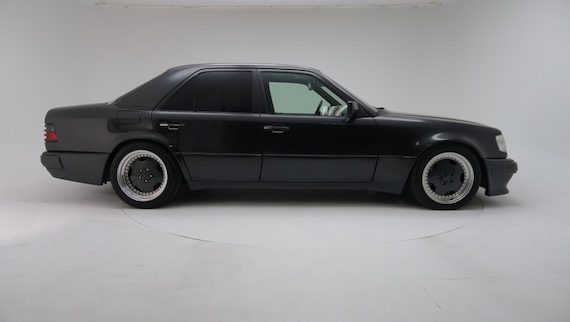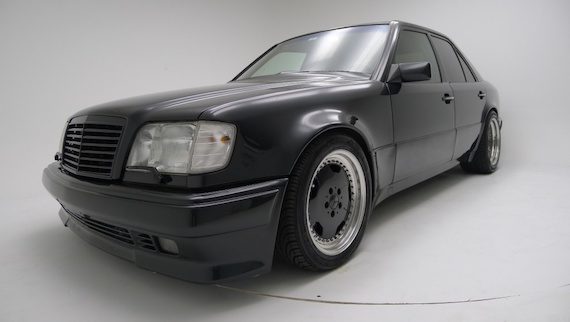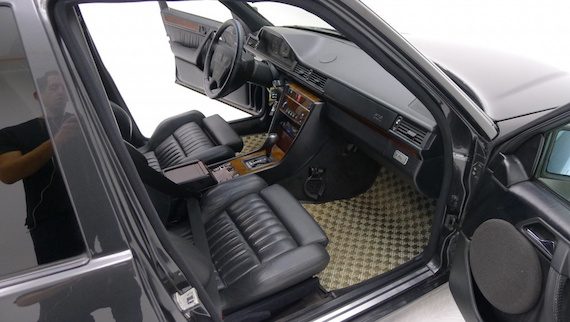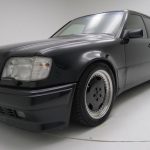The E60 AMG is an ultra rare, high-performance version of the W124 E-class dating from the pre-merger era, i.e. before AMG was officially folded into the Mercedes-Benz family. The E60, of which only around 126 were ever built, began life as a 500E, already a rather special car and the product of a Porsche-Mercedes collaboration. Should a buyer select option code 957, their 500E would be sent to the tuners at Affalterbach for further upgrades and come back rebadged as an E60. These upgrades included tweaks to the suspension and a larger, 6.0 liter version of the M119 V8 engine, the same motor as in the famed AMG “Hammer,” pushing power to 376 hp (edit: see the note from Glenn in the comments section re: Hammer).
CLICK FOR DETAILS: 1991 Mercedes-Benz E60 AMG on Classic Driver
 Year: 1991
Year: 1991
Model: E60 AMG
Engine: 6.0 liter V8
Transmission: 4-speed automatic
Mileage: 12,428 mi
Price: $75,000

This 1991 Mercedes Benz is a pre merge AMG 6.0, 1 owner car is offered for the first time in USA, with the previous owner being a AMG enthusiast in Japan. This particular model is the 4-door variant, and is equipped with the 6.0L, found in the same bodied E60. The AMG is on impressive condition, has only 20.000 km from new, and wears probably the best color combo offered.
The big aero monoblock wheels were the perfect match for the body kit components on this car, and the outer lips set things off nicely. . This one shows the perfect stance.
This car offered with partial service history and all books and manuals in leather AMG pouch.
This car offers an interesting contrast to the 500E that was built on the same platform. This car is feels faster and more balanced compared to 500 E. The later merge AMG cars came later, and not offer same quality ,noise and feel as a pre merge cars.
A VIN check of this car does not show the 957 option code, which suggests that rather than being ordered from the factory as an E60, this car left Germany as a 500E and was then upgraded by a local AMG tuner once it arrived in Japan, where it spent its life before being imported to the US (the car is being offered for sale by a specialist dealer in Philadelphia). I’ll leave it to the AMG enthuasiasts and historians to debate whether this means it’s an “authentic” E60. I believe it is, and the difference between those that left the factory as E60s and those that were converted afterward is really just a distinction between cars that are “ultra, ultra rare” and cars that are simply “ultra rare.”
The blue-black paint (code 199) looks gorgeous and sufficiently menacing over the black leather interior (replete with what appear to be Recaro seats taken from the Death Star), and is set off very nicely by the color-coded, 3-piece AMG rims. The mileage on this example is an incredibly low 12k miles, which would seem to justify the collector-level price. Since cars with very low mileage sourced from Japan can look wonderfully clean on the outside but show neglected internals, potential buyers would want to inspect the car closely, paying particular attention to the partial maintenance history and AMG Japan documentation that is said to be available.
Thanks to our reader Nik for sending this listing in!
– Craig









wow
Nice. But let’s clarify something that I see mis-stated quite often. The AMG Hammers were NOT powered by the M119 engine. The M119’s are Mercedes production engines with 4-valve heads. 500E’s used M119’s, as did the R129 500SL and S-class cars too. The E60’s used the M119, albeit bored out and with a stroker crank along the lines of the earlier M117 560’s to achieve their increased displacement.
On the other hand, true AMG Hammers used the earlier M117 lower end, but had proprietary custom cast AMG 4-valve per cylinder heads mounted onto the M117 block. Seems somewhat esoteric, but it is a big difference. And it’s easy to tell them apart with one quick glance under the hood.
I’ve owned 500E’s and still have one, but let me tell you something. Years ago, I met a character at the Mercedes dealer in Calabasas looking for an oil filter. (!) He had purchased a white Hammer from a doctor in the Southeast – the same AMG Hammer used in some old magazine tests. We went for a ride… and OMG the *torque* – that car was a BEAST, blasting up the Las Virgenes grade on the 101 like the laws of physics had been revoked and gravity didn’t exist. Amazing car for it’s era. For a Hammer, blowing exotics out of the water was like shooting fish in a barrel.
Very informative comment Glenn, thanks for catching that!
I think the confusion comes because the Hammer 6.0 motor is 117/9, right? Most people probably figure that’s the same as 119.
How’s about some TMI? 🙂
The lineage for the M117’s can be a bit confusing. The original design was the 3.5 liter M116 – a wonderful & lively little screamer of a motor when in European tune. I had an old EFI gray-market 350SLC that I loved.
The M117 was essentially a tall deck version of M116 to allow for a much longer stroke without creating too much angular side thrust on the cylinder walls. That good old bulletproof 450 engine was in production for many years before being supplanted by the *aluminum block* M117.
That’s one source of confusion: The M117 designation was applied to BOTH the iron block engines AND the later aluminum blocks.
The aluminum block M117’s were introduced in the late 1970’s in the 450SLC 5.0, a lightweight homolgation special incorporating (some) aluminum body panels, bumpers, trailing arms and a few other bits & pieces. (I had one of those too, and I miss it dearly!) Those early 5.0 blocks displaced a few CC’s over 5-liters, (5,025 IIRC?) but had a propensity for developing cracked cylinder walls due to localized overheating from the siamesed bores. Those early “bad boy” motors put out a lot more HP than the factory listed – estimated to be in the 330+hp range. They are also unique in that they have a bellhousing bolt pattern that matches up to the 3-speed gearbox. (0-60mph in first gear!) MBZ sort of used the buyers of 450SLC 5.0’s as beta testers or guinea pigs for development engineering on those early aluminum blocks, and a good number of those engines were replaced under warranty.
The *production* version aluminum block M117’s used in the “500” series cars from 1980 & onward had reduced cylinder bores with water jacketing between the cylinders, milder cams, and different cylinder heads. Their displacement was slightly under 5-liters, and they had the bellhousing pattern that fits the 4-speed gearboxes.
Mercedes later went on to put an even longer throw crankshaft into the aluminum M117’s, thus the 560 engine was born. There were also 3.8 liter aluminum M117’s, using two different variations of bore and stroke (depending on date of manufacture) to achieve that displacement. (Don’t remind people about the single row timing chain on early U.S. 380 cars – what an idiotic move!)
And then you (finally getting back on point) have the AMG designed & engineered twin cam 4-valve cylinder heads that were used by AMG on their highest $$$ builds. THOSE are what differentiates a Hammer from everything else. Don’t get me wrong, I’d love to have this 6-liter M119 powered 500E (W124.036) but it’s not a Hammer in the truest sense of the moniker. The very limited production E60’s were butt kickers in their own right.
And as a final overload of borderline useless information: The M119’s (which of course have MBZ’s twin-cam 4-valve heads) are wonderful beasts themselves. They are close enough in architecture to allow the long-throw 560 crank to be adapted, a relatively cost effective course of action used by several tuners. Of course, “cost effective” is a relative term…
Awesome info, Glenn – thanks for the comments!
Here’s a 1980 in Chicago….http://www.carandclassic.co.uk/car/C161068
Whew, blast from the past. Wrote that car up about 2.5 years ago, doesn’t look like much changed:
https://germancarsforsaleblog.com/homologation-special-1979-and-1980-mercedes-benz-450slc-5-0s/
Nice find. A blast from the past for me. Thanks!
I had chassis #113, which I still regret selling. But it went to the Netherlands for a full restoration – so she’s probably in good hands now. It, like the majority of (used) gray market 107’s, was a rustbucket… but a damn fun one. The 450 SLC 5.0’s have a completely different character than the 450’s. Similar in concept & layout, completely different in character. Sort of like a w124 400E versus a 500E. Both are very nice cars, but the 500E is an animal compared to it’s more sedate sister.
Something seems a little off on that listing, but it could be nothing. I find the mileage to be almost unbelievable at only 14,000 miles, but she does present cleanly. It’s listed as a 1980, but that chassis number probably should be a 1979… but close to the 1980 production run.
Why does that matter? Because there is a BIG difference. The early cars (’78 & ’79) got the “Bad Boy” heavy-breathing big-cam motor that I spoke of earlier – mated to the 3-speed automatic, and the ’80 & ’81’s; had the regular production 500 motors mated to the new (at the time) 4-speed autobox. The nomenclature also changed on the late cars to “500SLC”, whereas the early cars are “450SLC 5.0”.
There’s also a bit of misinformation in the ad. 107.026’s were not brought into the U.S. during their production run. IIRC one car made it’s way to the US for a MBZ executive, but that’s it. The rest were brought in as used gray market cars. The trunklid spoiler delete option caused a normal steel trunklid to be installed, but not for weight reasons. The aluminum lids were very flimsy, and the spoiler (although a soft urethane type material) served to reinforce the lid along that delicate rear radius. The aluminum stampings *may* have also had the holes for the spoiler pre-punched, thus negating the ability to mount them sans spoiler. That’s speculation on my part though.
I may not live long enough to see it, but the early 107.026 cars with their outstanding rarity, historical significance as the development showcase for advanced (for the time) aluminum technologies, and the fact that they were factory homolgation specials will possibly make today’s pricing seem tame in retrospect. Not like $7,500 Cobra’s or $10,000 Ferrarri’s, but a bargain nonetheless.